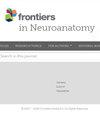The arrangements of the microvasculature and surrounding glial cells are linked to blood–brain barrier formation in the cerebral cortex
IF 2.3
4区 医学
Q1 ANATOMY & MORPHOLOGY
引用次数: 0
Abstract
The blood–brain barrier (BBB) blocks harmful substances from entering the brain and dictates the central nervous system (CNS)-specific pharmacokinetics. Recent studies have shown that perivascular astrocytes and microglia also control BBB functions, however, information about the formation of BBB glial architecture remains scarce. We investigated the time course of the formation of BBB glial architecture in the rat brain cerebral cortex using Evans blue (EB) and tissue fixable biotin (Sulfo-NHS Biotin). The extent of the leakage into the brain parenchyma showed that the BBB was not formed at postnatal Day 4 (P4). The BBB gradually strengthened and reached a plateau at P15. We then investigated the changes in the configurations of blood vessels, astrocytes, and microglia with age by 3D image reconstruction of the immunohistochemical data. The endfeet of astrocytes covered the blood vessels, and the coverage rate rapidly increased after birth and reached a plateau at P15. Interestingly, microglia were also in contact with the capillaries, and the coverage rate was highest at P15 and stabilized at P30. It was also clarified that the microglial morphology changed from the amoeboid type to the ramified type, while the areas of the respective contact sites became smaller during P4 and P15. These results suggest that the perivascular glial architecture formation of the rat BBB occurs from P4 to P15 because the paracellular transport and the arrangements of perivascular glial cells at P15 are totally the same as those of P30. In addition, the contact style of perivascular microglia dramatically changed during P4-P15.微血管和周围神经胶质细胞的排列与大脑皮层血脑屏障的形成有关
血脑屏障(BBB)阻止有害物质进入大脑,并决定着中枢神经系统(CNS)特有的药代动力学。最近的研究表明,血管周围的星形胶质细胞和小胶质细胞也控制着血脑屏障的功能,但有关血脑屏障胶质结构形成的信息仍然很少。我们使用伊文思蓝(EB)和组织可固定生物素(Sulfo-NHS 生物素)研究了大鼠大脑皮层中 BBB 胶质结构形成的时间过程。渗漏到脑实质的程度表明,出生后第 4 天(P4)时 BBB 尚未形成。BBB逐渐加强,在出生后第15天达到高峰。随后,我们通过对免疫组化数据进行三维图像重建,研究了血管、星形胶质细胞和小胶质细胞的构型随年龄的变化。星形胶质细胞的内足覆盖了血管,覆盖率在出生后迅速增加,并在 P15 达到高峰。有趣的是,小胶质细胞也与毛细血管接触,其覆盖率在 P15 时最高,在 P30 时趋于稳定。研究还发现,小胶质细胞的形态在P4和P15期间从变形型变为柱状型,同时各自接触部位的面积变小。这些结果表明,大鼠 BBB 的血管周围神经胶质结构形成发生在 P4 至 P15 期,因为 P15 期的血管旁运输和血管周围神经胶质细胞的排列与 P30 期完全相同。此外,血管周围小胶质细胞的接触方式在P4-P15期间发生了显著变化。
本文章由计算机程序翻译,如有差异,请以英文原文为准。
求助全文
约1分钟内获得全文
求助全文
来源期刊

Frontiers in Neuroanatomy
ANATOMY & MORPHOLOGY-NEUROSCIENCES
CiteScore
4.70
自引率
3.40%
发文量
122
审稿时长
>12 weeks
期刊介绍:
Frontiers in Neuroanatomy publishes rigorously peer-reviewed research revealing important aspects of the anatomical organization of all nervous systems across all species. Specialty Chief Editor Javier DeFelipe at the Cajal Institute (CSIC) is supported by an outstanding Editorial Board of international experts. This multidisciplinary open-access journal is at the forefront of disseminating and communicating scientific knowledge and impactful discoveries to researchers, academics, clinicians and the public worldwide.
 求助内容:
求助内容: 应助结果提醒方式:
应助结果提醒方式:


